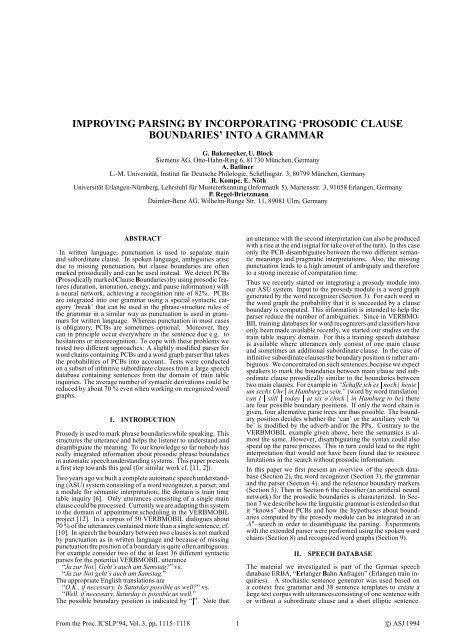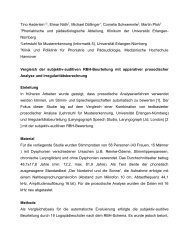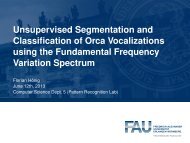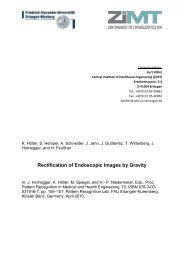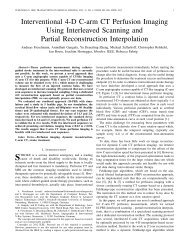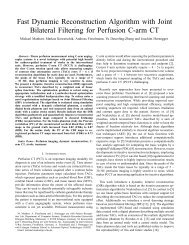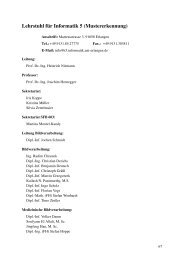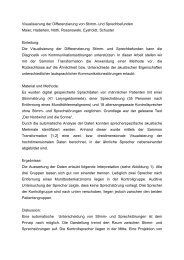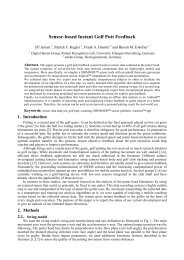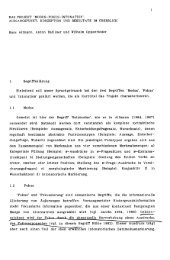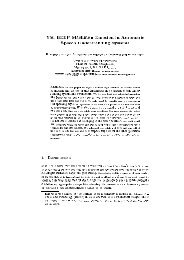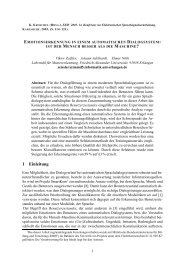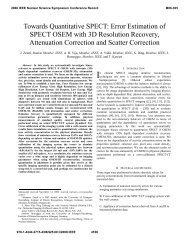'prosodic clause boundaries' into a grammar - Lehrstuhl für ...
'prosodic clause boundaries' into a grammar - Lehrstuhl für ...
'prosodic clause boundaries' into a grammar - Lehrstuhl für ...
You also want an ePaper? Increase the reach of your titles
YUMPU automatically turns print PDFs into web optimized ePapers that Google loves.
IMPROVING PARSING BY INCORPORATING ‘PROSODIC CLAUSE<br />
BOUNDARIES’ INTO A GRAMMAR<br />
G. Bakenecker, U. Block<br />
Siemens AG, Otto-Hahn-Ring 6, 81730 München, Germany<br />
A. Batliner<br />
L.-M. Universität, Institut für Deutsche Philologie, Schellingstr. 3, 80799 München, Germany<br />
R. Kompe, E. Nöth<br />
Universität Erlangen-Nürnberg, <strong>Lehrstuhl</strong> für Mustererkennung (Informatik 5), Martensstr. 3, 91058 Erlangen, Germany<br />
P. Regel-Brietzmann<br />
Daimler-Benz AG, Wilhelm-Runge Str. 11, 89081 Ulm, Germany<br />
ABSTRACT<br />
In written language, punctuation is used to separate main<br />
and subordinate <strong>clause</strong>. In spoken language, ambiguities arise<br />
due to missing punctuation, but <strong>clause</strong> boundaries are often<br />
marked prosodically and can be used instead. We detect PCBs<br />
(Prosodically marked Clause Boundaries) by using prosodic features<br />
(duration, <strong>into</strong>nation, energy, and pause information) with<br />
a neural network, achieving a recognition rate of 82%. PCBs<br />
are integrated <strong>into</strong> our <strong>grammar</strong> using a special syntactic category<br />
‘break’ that can be used in the phrase-structure rules of<br />
the <strong>grammar</strong> in a similar way as punctuation is used in <strong>grammar</strong>s<br />
for written language. Whereas punctuation in most cases<br />
is obligatory, PCBs are sometimes optional. Moreover, they<br />
can in principle occur everywhere in the sentence due e.g. to<br />
hesitations or misrecognition. To cope with these problems we<br />
tested two different approaches: A slightly modified parser for<br />
word chains containing PCBs and a word graph parser that takes<br />
the probabilities of PCBs <strong>into</strong> account. Tests were conducted<br />
on a subset of infinitive subordinate <strong>clause</strong>s from a large speech<br />
database containing sentences from the domain of train table<br />
inquiries. The average number of syntactic derivations could be<br />
reduced by about 70 % even when working on recognized word<br />
graphs.<br />
I. INTRODUCTION<br />
Prosody is used to mark phrase boundaries while speaking. This<br />
structures the utterance and helps the listener to understand and<br />
disambiguate the meaning. To our knowledge so far nobody has<br />
really integrated information about prosodic phrase boundaries<br />
in automatic speech understanding systems. This paper presents<br />
a first step towards this goal (for similar work cf. [11, 2]).<br />
Two years ago we built a complete automatic speechunderstanding<br />
(ASU) system consisting of a word recognizer, a parser, and<br />
a module for semantic interpretation; the domain is train time<br />
table inquiry [6]. Only utterances consisting of a single main<br />
<strong>clause</strong> could be processed. Currently we are adapting this system<br />
to the domain of appointment scheduling in the VERBMOBIL<br />
project [12]. In a corpus of 50 VERBMOBIL dialogues about<br />
70 % of the utterances contained more than a single sentence, cf.<br />
[10]. In speech the boundary between two <strong>clause</strong>s is not marked<br />
by punctuation as in written language and because of missing<br />
punctuation the position of a boundary is quite often ambiguous.<br />
For example consider two of the at least 36 different syntactic<br />
parses for the potential VERBMOBIL utterance<br />
“Ja zur Not. Geht’s auch am Samstag” vs.<br />
“Ja zur Not geht’s auch am Samstag.”<br />
The appropriate English translations are<br />
“O.K., if necessary. Is Saturday possible as well” vs.<br />
“Well, if necessary, Saturday is possible as well.”<br />
The possible boundary position is indicated by “ ”. Note that<br />
an utterance with the second interpretation can also be produced<br />
with a rise at the end (signal for take over of the turn). In this case<br />
only the PCB disambiguates between the two different semantic<br />
meanings and pragmatic interpretations. Also, the missing<br />
punctuation leads to a high amount of ambiguity and therefore<br />
to a strong increase of computation time.<br />
Thus we recently started on integrating a prosody module <strong>into</strong><br />
our ASU system. Input to the prosody module is a word graph<br />
generated by the word recognizer (Section 3). For each word in<br />
the word graph the probability that it is succeeded by a <strong>clause</strong><br />
boundary is computed. This information is intended to help the<br />
parser reduce the number of ambiguities. Since in VERBMO-<br />
BIL training databases for word recognizers and classifiers have<br />
only been made available recently, we started our studies on the<br />
train table inquiry domain. For this a training speech database<br />
is available where utterances only consist of one main <strong>clause</strong><br />
and sometimes an additional subordinate <strong>clause</strong>. In the case of<br />
infinitive subordinate <strong>clause</strong>s the boundary position is rather ambiguous.<br />
We concentrated on such sentences, because we expect<br />
speakers to mark the boundaries between main <strong>clause</strong> and subordinate<br />
<strong>clause</strong> prosodically similar to the boundaries between<br />
two main <strong>clause</strong>s. For example in “Schaffe ich es noch heute<br />
um sechs Uhr in Hamburg zu sein.” (word by word translation:<br />
can I still today at six o’clock in Hamburg to be) there<br />
are four possible boundary positions. If only the word chain is<br />
given, four alternative parse trees are thus possible. The boundary<br />
position decides whether the ‘can’ or the auxiliary verb ‘to<br />
be’ is modified by the adverb and/or the PPs. Contrary to the<br />
VERBMOBIL example given above, here the semantics is almost<br />
the same. However, disambiguating the syntax could also<br />
speed up the parse process. This in turn could lead to the right<br />
interpretation that would not have been found due to resource<br />
limitations in the search without prosodic information.<br />
In this paper we first present an overview of the speech database<br />
(Section 2), the word recognizer (Section 3), the <strong>grammar</strong><br />
and the parser (Section 4), and the reference boundary markers<br />
(Section 5), Then in Section 6 the classifier (an artificial neural<br />
network) for the prosodic boundaries is characterized. In Section<br />
7 we describe how the linguistic <strong>grammar</strong> is extended so that<br />
it “knows” about PCBs and how the hypotheses about boundaries<br />
computed by the prosody module can be integrated in ¡£¢<br />
an<br />
–search in order to disambiguate the parsing. Experiments<br />
with the extended parser were performed using the spoken word<br />
chains (Section 8) and recognized word graphs (Section 9).<br />
II.<br />
SPEECH DATABASE<br />
The material we investigated is part of the German speech<br />
database ERBA, “Erlanger Bahn Anfragen” (Erlangen train inquiries).<br />
A stochastic sentence generator was used based on<br />
a context free <strong>grammar</strong> and 38 sentence templates to create a<br />
large text corpus with utterances consisting of one sentence with<br />
or without a subordinate <strong>clause</strong> and a short elliptic sentence.<br />
From the Proc. ICSLP’94, Vol. 3, pp. 1115–1118 1 c ASJ 1994<br />
¤
10,000 unique sentences were recorded in quiet office environments<br />
(100 untrained speakers, 100 utterances each) resulting<br />
in a speech database of about 14 hours. The speakers were<br />
given the word sequences with punctuation marks, but without<br />
the prosodic phrase boundary markers. 69 speakers (25 female,<br />
6,900 sentences) were used for training and 21 speakers (9 female,<br />
2,100 sentences) for testing the word recognition module<br />
as well as the classifier for the prosodic boundaries. For more<br />
details concerning ERBA see [1].<br />
The <strong>grammar</strong> described in Section 4 is only able to parse 4,480 of<br />
the 10,000 spoken word chains, because e.g. it was not designed<br />
to handle elliptic sentences. In the set of 4,480 sentences there<br />
are 1,504 sentences with subordinate <strong>clause</strong>s (and thus with a<br />
potential PCB), 272 of them being infinitive <strong>clause</strong>s (i.e. the<br />
PCB could help disambiguate between the possible parses). As<br />
mentioned above, the low percentage of interesting sentences<br />
is due to the construction of the corpus and way higher for the<br />
VERBMOBIL data. Due to technical problems only 242 of<br />
these 272 sentences could be used in the experiments described<br />
in Section 9. Note that about two third of these sentences were<br />
in the training set for both the word recognizer and the classifier<br />
for the PCBs. However, in the case of the PCB the recognition<br />
rates of training and test set do not differ significantly.<br />
III.<br />
WORD RECOGNIZER<br />
The Daimler-Benz speech recognition system is based on semicontinuous<br />
Hidden Markov Models (SCHMM) of subword units<br />
(generalized triphones and functional words) [4, 5]. We use<br />
13 normalized mel–based cepstral features with a centisecond<br />
frame rate. Combinations of feature vectors from 9 adjacent<br />
frames (dimension 117) are transformed by a linear transform<br />
generated by linear discriminant analysis. This results in a 32<br />
dimensional feature vector which implicitly includes temporal<br />
dynamic effects. The multistage training procedure is described<br />
in [4]. The output of our recognizer is a word hypotheses graph.<br />
IV.<br />
GRAMMAR AND PARSER<br />
We use a Trace and Unification Grammar (TUG) [3] and a<br />
modification of the parsing algorithm of Tomita [9]. The basis of<br />
a TUG is a context free <strong>grammar</strong> augmented with PATR-II-style<br />
feature equations. The Tomita parser uses a graph-structured<br />
stack as central data structure. After processing word w the<br />
top nodes of this stack keep track of all partial derivations for<br />
w 1...w . In [8], a parsing-scheme for word graphs is presented<br />
using this parser. It combines different knowledge sources when<br />
searching the word graph for the spoken utterance: a TUG, a<br />
statistical bigram model and the score of the acousticcomponent.<br />
When searching the word graph partial sentence hypotheses are<br />
organized as a tree. A graph-structured stack of the Tomita parser<br />
is associated with each node. In the search an agenda of scoreranked<br />
orders to extend a partial sentence hypothesis (hypo =<br />
hypo(w 1,...,w )) by a word w ¢¡ 1 is processed: The best entry<br />
is taken; if the associated graph-structured stack of the parser<br />
can be extended by w £¡ 1 new orders are inserted in the agenda<br />
for combining the extended hypothesis hypo £¡ 1 with the then<br />
following words. Otherwise, no entries will be inserted. Thus,<br />
the <strong>grammar</strong> makes hard decisions on whether a hypothesis is<br />
accepted or not. The other two knowledge sources (the acoustic<br />
and the bigram model) deliver scores which are combined to give<br />
the score for an entry of the agenda:<br />
& §©¤¥§©§ <br />
¤¦¥¨§©§<br />
"¥ ¤¥§#©$ §©%& '(*)+ -,©.<br />
¥§¤!<br />
‘<br />
¤¥§© / "0+ §©<br />
7.8&5¥§9! 7§9:;<br />
¤¥§©1§#23§456 "9:!<br />
Alpha is determined heuristically. Prior to parsing a Viterbi-like<br />
backward pass computes the exact scores of optimal continuations<br />
of partial sentence hypotheses( –search). After a certain<br />
time has elapsed the search is abandoned.<br />
¢ ¡<br />
V. REFERENCE BOUNDARY MARKERS<br />
Prosodic phrase boundaries can be predicted quite accurately<br />
using syntactic knowledge. Syntactic boundaries were therefore<br />
marked in the context free <strong>grammar</strong> (Section 2) and included<br />
in the sentence generation process with some context-sensitive<br />
post-processing (cf. below: B1 boundaries). The text read by<br />
the speakers did not contain these markers.<br />
We distinguish four types of phrase boundaries: Boundary B3<br />
is placed between elliptic <strong>clause</strong> and <strong>clause</strong> or between main<br />
and subordinate <strong>clause</strong>, B2 is positioned between constituents<br />
or at coordinating particles between constituents, B1 belongs<br />
syntactically to the normal constituent boundary B2 but is most<br />
certainly not marked prosodically because it is close to a B3<br />
boundary or to the beginning/end of the utterance, and B0 is any<br />
other word boundary that does not belong to B1, B2 , B3; for<br />
more details see [1]. The following sentence shows examples<br />
for these boundary types: “Guten Morgen B3 ich hätte gerne B1<br />
einen Zug B3 der München B2 zwischen sechs B2 und sieben<br />
Uhr B1 verläßt” (word by word translation: “Good morning<br />
B3 I would like B1 a train B3 that Munich B2 between six B2<br />
and seven o’clock B1 leaves”. In the ERBA corpus, 62097 B0,<br />
18657 B1, 22616 B2, and 3877 B3 boundaries are generated<br />
automatically.<br />
A perception experiment was conducted with “naive” listeners<br />
[1]. It showed that there is a very high agreement between<br />
the automatically generated reference boundaries and perceived<br />
boundaries.<br />
VI.<br />
AUTOMATIC BOUNDARY CLASSIFICATION<br />
The classification of prosodic phrase boundaries is based on the<br />
time alignment of the recognized/spoken words. For the final<br />
syllable of each word prosodic features (duration, <strong>into</strong>nation,<br />
intensity, and pause information) are computed; as for more<br />
details, cf. [7]. There we reported an average error rate of<br />
60% for the three classes B01, B2, and B3 using a Gaussian<br />
classifier. Meanwhile we improved the recognition rate to 72%<br />
with an improved feature set, modeling multi–modality, and<br />
using multi–layer perceptrons (MLP).<br />
The durational features highly depend on the underlying syllable.<br />
Thus when working on word graphs for each of the words<br />
ending in the same node a different feature vector is computed as<br />
input for the MLP. The probability for a PCB in a node depends<br />
very much on the word under consideration and is computed<br />
for each of the words separately. Our ASU system works in<br />
bottom–up manner, i.e. first the word graph is computed for the<br />
whole utterance, then the MLP computes likelihoods for PCBs,<br />
and finally the word graph is parsed. Thus when computing the<br />
likelihoods for the PCBs the syllables succeeding the final syllable<br />
of a word are not known (or the likelihood would have to<br />
be calculated for each of the potential successor words). Therefore<br />
the length of a syllable to the right of the potential PCB is<br />
defined as 200 msec for the computation of the F0 and intensity<br />
features. In comparison to the recognition rate using the time<br />
alignment of the best word chain this decreases the recognition<br />
rate on the three classes by about 2%, i.e. 70% for the three<br />
classes. For the two class problem B012 vs. B3 that is relevant<br />
for this paper we currently have 82%. This MLP was used for<br />
the experiments in Section 9. The experiments on the spoken<br />
word chain (Section 8) were performed some time ago using an<br />
older version of a Gaussian classifier with which a recognition<br />
rate of 56% for the three classes was achieved.<br />
VII.<br />
EXTENSION OF THE GRAMMAR AND THE<br />
PARSER<br />
We incorporated PCBs <strong>into</strong> <strong>grammar</strong> and parser in order to reduce<br />
the number of syntactic derivations and speed up parsing. In<br />
written language, commas are used to separate two main <strong>clause</strong>s<br />
and main and subordinate <strong>clause</strong>. Without punctuation marks,<br />
sentences like the following are ambiguous (translation word by<br />
word):<br />
2
¡<br />
¡<br />
Welche Möglichkeiten habe ich heute nach Hamburg zu kommen<br />
which possibilities have I today to Hamburg to go<br />
Table 1. Results for the spoken word chain<br />
‘heute’ (‘today’) can modify the main <strong>clause</strong> or the subordinate<br />
E0 E1 E2 E3<br />
<strong>clause</strong>. In such cases PCBs can be used to replace punctuation.<br />
number of failed sentences<br />
In analogy to punctuation in written language, a special syntactic 4480 sentences 0 0 71 206<br />
category break for PCBs is introduced that can be used in the 1504 sentences 0 0 25 62<br />
phrase structure part of the <strong>grammar</strong>. E.g. the rule<br />
272 infinitivesentences<br />
0 0 5 27<br />
INPUT sub<strong>clause</strong>-inf , main-<strong>clause</strong><br />
is modified to<br />
comparison for the 245 infinitive <strong>clause</strong>s<br />
INPUT sub<strong>clause</strong>-inf , break , main-<strong>clause</strong> .<br />
average number of<br />
A <strong>grammar</strong> with obligatory PCBs only includes the rules with derivations 8.1 4.03 4.14 2.44<br />
the break category, a <strong>grammar</strong> with optional PCBs includes max number of<br />
the rules with and without the break category. In [2] a similar<br />
approach was followed, but a special category was inserted average runtime secs 8.06 4.31 4.59 4.04<br />
derivations 209 39 39 38<br />
between every two adjacent symbols on the right hand side of max runtime 235.02 33.07 36.78 29.38<br />
each <strong>grammar</strong> rule. In the average this resulted in an increase in<br />
parsing time.<br />
-,©. ¤¥§#©¦ (/)+ &<br />
We implemented two basically different approaches. In / £¡ the "0+/ first<br />
1<br />
approach 6*<br />
7§9:;<br />
(see experiment E1 in Section<br />
¤¥§©1§#23§456 "9:!<br />
8) the input to the ‘<br />
7.8&5¥§9!<br />
parser is an ASCII-string that includes the probability of a PCB<br />
between adjacent words:<br />
The exact scores of optimal continuations of partial sentence<br />
hypotheses are determined using the best of the two prosodic<br />
welche 0.21 Möglichkeiten 0 habe 0.11 ich 0.14 nach 0.16 drei scores.<br />
0 Uhr 0 nach 0.01 Goslar 0.1 zu 0 kommen<br />
which possibilities have I after three o’clock to Goslar to go<br />
welche 0.23 Möglichkeiten 0.01 habe 0.11 ich 0.14 in 0.77 VIII. EXPERIMENTS USING THE SPOKEN WORD<br />
fünf 0.28 Wochen 0.02 von 0 Eberswalde 0.01 nach 0 Bodenwöhr<br />
Nord 0.82 über 0 Mannheim 0 zu 0 fahren<br />
CHAIN<br />
which possibilities have I in five weeks from Eberswalde to Bodenwöhr<br />
Nord via Mannheim to go<br />
The probability of PCBs are inserted automatically between ad-<br />
In the following experiments the spoken word chain was used.<br />
Using a threshold of 0.5 the probabilities are first transformed<br />
jacent words. The word chain can easily be transformed <strong>into</strong> a<br />
<strong>into</strong> hard decisions yielding:<br />
word graph: Each word is assigned the acoustic score 0. When<br />
searching on this word graph the bigram model is of no use and<br />
(1) welche Möglichkeiten habe ich nach drei Uhr nach Goslar the bigram score can be ignored, i.e. the score of a hypothesis is<br />
zu kommen<br />
the prosodic score. When using a <strong>grammar</strong> with optional PCBs<br />
the word graph parser searches for the best PCBs within the sentence<br />
that are accepted by the <strong>grammar</strong>, eventually omitting all<br />
(2) welche Möglichkeiten habe ich in B3 fünf Wochen von Eberswalde<br />
nach Bodenwöhr Nord B3 über Mannheim zu fahren<br />
PCBs. When using a <strong>grammar</strong> with obligatory PCBs the word<br />
(1) indicates that PCBs are not always produced or recognized graph parser is forced to decide where to place the boundary and<br />
and according to (2) they can in principal be hypothesized everywhere<br />
in the sentence due e.g. to hesitations or misrecognition. fail to parse the sentence in case a PCB is recognized with prob-<br />
chooses the optimal position accepted by the <strong>grammar</strong>. It can<br />
To account for (1) the parser uses a <strong>grammar</strong> with optional ability 1 at a position in the sentence where the <strong>grammar</strong> would<br />
PCBs and to account for additional PCBs as in (2) the parser not allow any. When using a <strong>grammar</strong> with obligatory PCBs<br />
is slightly modified: In case of failure it skips the previously it can also fail if PCBs are recognized with probability 0 at all<br />
consumed PCB and continues parsing from that point on. In (2) possible positions in the utterance.<br />
the parser fails to consume the first B3 because infinitive subordinate<br />
<strong>clause</strong>s can not start after a preposition. The first B3 is<br />
In the following four experiments (E0 - E3) are compared:<br />
skipped and the parser succeeds.<br />
E0: uses the original sentence parser and <strong>grammar</strong> and ignores<br />
There can be several possibilities which PCBs to skip and which PCBs<br />
to consume. One disadvantage of this approach is that the parser<br />
does not choose the optimal possibility.<br />
E1: uses the modified sentence parser and <strong>grammar</strong> with optional<br />
PCBs<br />
In the second approach (see experiments E2 and E3 in Section 8)<br />
we use the word graph parser. Each hypothesisof the word graph E2: uses the modified word graph parser and <strong>grammar</strong> with<br />
includes two additional scores, one for ‘a PCB is following’ and optional PCBs<br />
the other for ‘no PCB is following’. The word graph parser has<br />
been modified to take PCBs <strong>into</strong> account: After adding a word E3: uses the modified word graph parser and <strong>grammar</strong> with<br />
w 1 to a partial sentence ¢¡ hypothesis hypo = hypo(w 1,...,w ) an obligatory PCBs<br />
order for combining the new partial £¡ sentence hypothesishypo 1<br />
with a B3 (1) and orders for combining it with the then following<br />
In Table 1 the number of failed sentences, the average number of<br />
words (2) are inserted <strong>into</strong> the agenda. When adding B3 to a<br />
derivations and runtime and the maximal number of derivations<br />
hypothesis only orders for combining it with following words<br />
and runtime are given for these four experiments and for the 245<br />
(3) are inserted. The scoring function has been modified to take<br />
sentences which could be processed successfully in all experiments.<br />
As can be seen the average number of derivations and<br />
the prosodic score <strong>into</strong> account:<br />
& 3 1 runtime is reduced by about 50<br />
: ¤¦¥¨§©§<br />
% when incorporating PCBs as<br />
¡ ¤¥§#©¦'§ ¡<br />
‘ hard decisions <br />
79:6 ¥¨§96 (E1). & Taking (£¢¥¤ <strong>into</strong> ". ! ¤¥§#©1§23§+ :<br />
account ¤¥§© / )46 the probability of 7§#9;<br />
PCBs<br />
1 2<br />
and : using ¤¦¥¨§©§ &/<br />
a <strong>grammar</strong><br />
¢¡<br />
with optional PCBs (E2) results in a similar<br />
(/9§ )46 ¤¥§© improvement, ¡ though about 2 % (5 7¥ cases) of ¢¥¤ the sentences fail.<br />
1 ¥§#¤6 * <br />
¤¥§©'§ ¢¡ ¤¥§©<br />
When forcing the<br />
/ /<br />
-,©.<br />
parser to find the )4 best ( position to & ¤¥§#©¦ place the<br />
1 *<br />
0+ £¡<br />
PCBs (E3) the average number of derivations is even reduced<br />
6:<br />
7.8&5¥§9! ‘ ¤¥§©1§#23§456 ; 7§9 "9:!<br />
by about 70 %, but the number of failed sentences increases to<br />
3 & 1 3 ¢¡ 0 10§¦¨¦£0+ 10 % (27 cases). We hope that improving recognition rates for<br />
¤¦¥¨§©§<br />
3 1 PCBs will decrease the number of failed sentences.<br />
* ¤¥§© 7¥<br />
¥§#¤6 6<br />
¢¡ / !0 10§¦¨¦£0+/ ¤¦¥¨§©§<br />
3
IX.<br />
Table 2. Results for real word graphs<br />
derivations runtime<br />
without prosody<br />
242 sentences - 13.74<br />
145 correct 8.97 5.31<br />
prosody 0.001<br />
242 sentences - 14.35<br />
144 + 0 correct 2.65 5.76<br />
prosody 0.01<br />
242 sentences - 14.15<br />
143 + 1 correct 2.65 5.89<br />
prosody 1<br />
242 sentences - 17.29<br />
142 + 1 correct 2.64 6.04<br />
prosody 10<br />
242 sentences - 21.99<br />
86 + 4 correct 2.12 7.55<br />
EXPERIMENTS USING THE RECOGNIZED<br />
WORD GRAPH<br />
In these experiments prosodic scores were attached to the word<br />
hypotheses of 242 word graphs for sentences with infinitive subordinate<br />
<strong>clause</strong>s. A <strong>grammar</strong> with obligatory PCBs was used.<br />
A bigram model was trained on about 4500 ERBA-sentences<br />
including the 242 sentences yielding a perplexity of 37 for the<br />
242 sentences. In 173 cases the spoken word chain was included<br />
in the word graph. Using no prosodic information 145 sentences<br />
were correctly recognized, in 75 cases a different sentence was<br />
accepted by the <strong>grammar</strong> (25 of these included the spoken word<br />
chain) and in the remaining 22 cases the time limit was reached.<br />
The prosodic score was included in the scoring-function with different<br />
factors: 0.001,0.01,1 and 10. Table 2 shows the average<br />
number of syntactic derivations and the average runtime, the first<br />
one only given for correctly recognized sentences. The number<br />
of correct sentences when using prosodic information is given<br />
as n 1 + n 2, n 1 sentences being part of the 145 sentences which<br />
were correctly recognized without using prosodic information.<br />
(Note that runtimes of Table 1 and Table 2 can not be compared<br />
because different machines were used). As can be seen the number<br />
of correctly recognized sentences decreases and the runtime<br />
increases when the factor with which the prosodic information is<br />
taken <strong>into</strong> account increases. Thus in these preliminary results<br />
the prosodic information did not lead to an increase in sentence<br />
recognition rate, but it helped to reduce the number of derivations<br />
by about 70 %. Up to a weighting factor of 1 the reduction in<br />
the recognition rate and the increase in the runtime are minute.<br />
This work was supportedby the GermanMinistry for Researchand Technology<br />
(BMFT) in the joint research projects ASL and VERBMOBIL.<br />
Only the authors are responsible for the contents.<br />
REFERENCES<br />
[1] A. Batliner, R. Kompe, A. Kießling, E. Nöth, H. Niemann, and<br />
U. Kilian. The prosodic marking of phrase boundaries: Expectations<br />
and Results. In A. Rubio, editor, New Advances and Trends<br />
in SpeechRecognition and Coding, NATO ASI Series F. Springer–<br />
Verlag, Berlin, Heidelberg, New York, 1994. (to appear).<br />
[2] J. Bear and P.J. Price. Prosody, syntax and parsing. In Proceedings<br />
of the ACL Conference, pages 17–22, 1990.<br />
[3] H. Block and S. Schachtl. Trace & unification <strong>grammar</strong>. In PROC.<br />
OF COLING-92, pages 87–93, Nantes, AUG 1992.<br />
[4] F. Class, A. Kaltenmeier, and P. Regel. Evaluation of an HMM<br />
Speech Recognizer with Various Continuous Speech Databases. In<br />
Proc. European Conf. on Speech Communication and Technology,<br />
volume 2, pages 803–806, Berlin, September 1993.<br />
[5] F. Class, A. Kaltenmeier, and P. Regel. Optimization of an HMMbased<br />
continuous Speech Recognizer. In Proc. European Conf. on<br />
Speech Communication and Technology, volume 3, pages 1587–<br />
1590, Berlin, September 1993.<br />
[6] P. Heisterkamp, S. McGlashan, and N.J. Youd. DialogueSemantics<br />
for a Spoken Dialogue System. In Proc. Int. Conf. on Spoken<br />
Language Processing, October 1992. Banff, Canada.<br />
[7] R. Kompe, A. Batliner, A. Kießling, U. Kilian, H. Niemann,<br />
E. Nöth, and P. Regel-Brietzmann. Automatic Classification of<br />
Prosodically Marked Phrase Boundaries in German. In Proc. Int.<br />
Conf. on Acoustics, SpeechandSignal Processing, volume2, pages<br />
173–176, Adelaide, 1994.<br />
[8] L. Schmid. Parsing Word Graphs Using a Linguistic Grammar<br />
and a Statistical Language Model. In Proceedings ICASSP, pages<br />
II–41–II44, 1994.<br />
[9] M. Tomita. Efficient Parsing for Natural Language: A Fast Algorithm<br />
for Practical Systems. Kluwer Academic Publishers, 1986.<br />
[10] H. Tropf. Spontansprachliche syntaktische Phänomene: Analyse<br />
eines Korpus aus der Domäne “Terminabsprache”. Technical report,<br />
Siemens AG, München, April 1994.<br />
[11] N.M. Veilleux, M. Ostendorf, and C.W. Wightman. Parse Scoring<br />
with Prosodic Information. In Int. Conf. on Spoken Language<br />
Processing, volume 3, pages 1605–1608, Banff, 1992.<br />
[12] W. Wahlster. Verbmobil — Translation of Face–To–Face Dialogs.<br />
In Proc. European Conf. on Speech Communication and Technology,<br />
volume “Openingand Plenary Sessions”, pages29–38, Berlin,<br />
September 1993.<br />
X. CONCLUSION<br />
In this paper we presented a first step towards the use of prosodic<br />
information during parsing. We showed that the number of<br />
alternative parse trees can be reduced significantly (about 70 %).<br />
However, so far it did not speed up the time needed for parsing<br />
word graphs. On the one hand, we believe that there is still room<br />
for improvement using other sets of features and improving the<br />
so far not optimized time alignment of the words in the word<br />
graph. On the other hand, when switching to spontaneousspeech<br />
we will have to deal with hesitations and changes of speaking<br />
rate within the same utterance. These phenomena must first be<br />
modeled before we can hope for similar reduction factors.<br />
Furthermore we intend to use prosodic boundary information<br />
for resolving other types of ambiguities such as the attachment<br />
of prepositional phrases, of appositions and of adverbials. Especially<br />
the attachment of prepositional phrases is rather ambiguous<br />
without information about phrase boundaries; e.g. “I<br />
saw the man with a telescope”, or “I want to take the train to<br />
Munich”.<br />
Acknowledgements<br />
4


